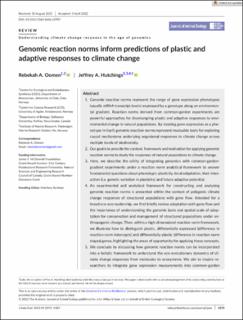| dc.contributor.author | Oomen, Rebekah Alice | |
| dc.contributor.author | Hutchings, Jeffrey | |
| dc.date.accessioned | 2023-01-04T13:40:39Z | |
| dc.date.available | 2023-01-04T13:40:39Z | |
| dc.date.created | 2022-08-10T13:22:31Z | |
| dc.date.issued | 2022 | |
| dc.identifier.citation | Oomen, R. A. & Hutchings, J. (2022). Genomic reaction norms inform predictions of plastic and
adaptive responses to climate change. Journal of Animal Ecology, 91(6), 1073-1087. doi: | |
| dc.identifier.issn | 0021-8790 | |
| dc.identifier.uri | https://hdl.handle.net/11250/3040988 | |
| dc.description.abstract | Genomic reaction norms represent the range of gene expression phenotypes (usually mRNA transcript levels) expressed by a genotype along an environmental gradient. Reaction norms derived from common-garden experiments are powerful approaches for disentangling plastic and adaptive responses to environmental change in natural populations. By treating gene expression as a phenotype in itself, genomic reaction norms represent invaluable tools for exploring causal mechanisms underlying organismal responses to climate change across multiple levels of biodiversity. Our goal is to provide the context, framework and motivation for applying genomic reaction norms to study the responses of natural populations to climate change. Here, we describe the utility of integrating genomics with common-garden-gradient experiments under a reaction norm analytical framework to answer fundamental questions about phenotypic plasticity, local adaptation, their interaction (i.e. genetic variation in plasticity) and future adaptive potential. An experimental and analytical framework for constructing and analysing genomic reaction norms is presented within the context of polygenic climate change responses of structured populations with gene flow. Intended for a broad eco-evo readership, we first briefly review adaptation with gene flow and the importance of understanding the genomic basis and spatial scale of adaptation for conservation and management of structured populations under anthropogenic change. Then, within a high-dimensional reaction norm framework, we illustrate how to distinguish plastic, differentially expressed (difference in reaction norm intercepts) and differentially plastic (difference in reaction norm slopes) genes, highlighting the areas of opportunity for applying these concepts. We conclude by discussing how genomic reaction norms can be incorporated into a holistic framework to understand the eco-evolutionary dynamics of climate change responses from molecules to ecosystems. We aim to inspire researchers to integrate gene expression measurements into common-garden experimental designs to investigate the genomics of climate change responses as sequencing costs become increasingly accessible. | |
| dc.language.iso | eng | |
| dc.rights | Navngivelse 4.0 Internasjonal | |
| dc.rights.uri | http://creativecommons.org/licenses/by/4.0/deed.no | |
| dc.title | Genomic reaction norms inform predictions of plastic and adaptive responses to climate change | |
| dc.title.alternative | Genomic reaction norms inform predictions of plastic and adaptive responses to climate change | |
| dc.type | Peer reviewed | |
| dc.type | Journal article | |
| dc.description.version | publishedVersion | |
| dc.description.version | publishedVersion | |
| dc.rights.holder | © 2022 Author(s) | |
| dc.source.pagenumber | 1073-1087 | |
| dc.source.volume | 91 | |
| dc.source.journal | Journal of Animal Ecology | |
| dc.source.issue | 6 | |
| dc.identifier.doi | 10.1111/1365-2656.13707 | |
| dc.identifier.cristin | 2042207 | |
| dc.description.localcode | Paid Open Access | |
| cristin.qualitycode | 2 | |

